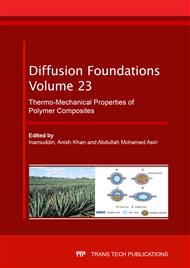[1]
C. Soutis, Fibre reinforced composites in aircraft construction, Progress in Aerospace Sciences. 41(2) (2005) 143–151.
DOI: 10.1016/j.paerosci.2005.02.004
Google Scholar
[2]
A.I. Vavouliotis, V. Kostopoulos, On the use of electrical conductivity for the assessment of damage in carbon nanotubes enhanced aerospace composites, In: A.S. Paipetis, V. Kostopoulos (Eds.), Carbon Nanotube Enhanced Aerospace Composite Materials: A New Generation of Multifunctional Hybrid Structural Composites, Springer, Dordrecht, (2013).
DOI: 10.1007/978-94-007-4246-8_2
Google Scholar
[3]
Y. Cui, S. Kumar, B.K. Rao and D. Van Houcke, Gas barrier properties of polymer/ clay nanocomposites, RSC Advances, (2015).
DOI: 10.1039/c5ra10333a
Google Scholar
[4]
P.M. Ajayan, L.S. Schadler, C. Giannaris and A. Rubio, Single-walled carbon nanotube–polymer composites: strength and weakness, Adv.Mater. 12(10) (2000) 750–753.
DOI: 10.1002/(sici)1521-4095(200005)12:10<750::aid-adma750>3.0.co;2-6
Google Scholar
[5]
A.K. Kothari, S. Hu, Z. Xia, E. Konca and B.W. Sheldon, Enhanced fracture toughness in carbon nanotube-reinforced amorphous silico nitride nanocomposite coatings, Acta Materialia. 60(8) (2012) 3333–3339.
DOI: 10.1016/j.actamat.2012.02.046
Google Scholar
[6]
Z. Xia, W.A. Curtin and B.W. Sheldon, Fracture toughness of highly ordered carbon nanotube/alumina nanocomposites, Journal of Engineering Materials and Technology. 126(3) (2000) 238–244.
DOI: 10.1115/1.1751179
Google Scholar
[7]
Y.L. Chen, B. Liu, X.Q. He, Y. Huang and K.C. Hwang, Failure analysis and the optimal toughness design of carbon nanotube-reinforced composites, Composites Science and Technology. 70(9) (2010) 1360–1367.
DOI: 10.1016/j.compscitech.2010.04.015
Google Scholar
[8]
Y. Ren, F. Li, H.M. Cheng and K. Liao, Tension–tension fatigue behaviour of unidirectional single-walled carbon nanotube reinforced epoxy composite, Carbon. 41(11) (2003) 2177–2179.
DOI: 10.1016/s0008-6223(03)00248-3
Google Scholar
[9]
K. Molnar, G. Szebenyi, B. Szolnoki, G. Marosi, L.M. Vas and A. Toldy, Enhanced conductivity composites for aircraft applications: carbon nanotube inclusion both in epoxy matrix and in carbonized electrospun nanofibers, Polymers for Advanced Technology. 25(9) (2014) 981–988.
DOI: 10.1002/pat.3339
Google Scholar
[10]
G. Pal, S. Kumar, Modeling of carbon nanotubes and carbon nanotube-polymer composites, Progress in Aerospace Sciences. 80 (2016) 33-58.
DOI: 10.1016/j.paerosci.2015.12.001
Google Scholar
[11]
M.J. Green, N. Behabtu, M. Pasquali and W.W. Adams, Nanotubes as Polymers, Polymer. 50 (2000) 4979-4997.
DOI: 10.1016/j.polymer.2009.07.044
Google Scholar
[12]
H. Wang: Dispersing carbon nanotubes using surfactants. Current Opinion in Colloid and Interface Science. 14 (2009) 364–371.
DOI: 10.1016/j.cocis.2009.06.004
Google Scholar
[13]
M. Granite, A. Radulesce, W.P. Hintzen and Y. Cohen, Interactions between block copolymers and single-walled carbon nanotubes in aqueous solutions: A small-angle neutron scattering study. Langmuir 27 (2011) 751–759.
DOI: 10.1021/la103096n
Google Scholar
[14]
R. Andrews, D. Jacques, D. Qian and T. Rantell, Multiwall carbon nanotubes: Synthesis and Applications, Accounts of Chemical Research. 35 (2002) 1008-1027.
DOI: 10.1021/ar010151m
Google Scholar
[15]
J.R. Utrilla, M.S. Polo, M.A.F. Garcia, G.P. Joya and R.O. Perez, Pharmaceuticals as emerging contaminants and their removal from water. A review, Chemosphere. 93(7) (2013) 1268-1287.
DOI: 10.1016/j.chemosphere.2013.07.059
Google Scholar


